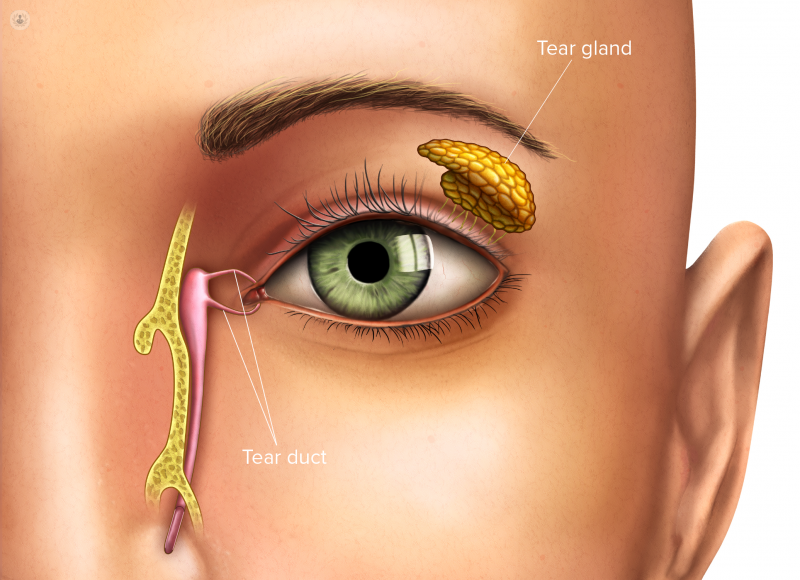Nasolacrimal duct obstruction causes blocked tear duct
Autore:Having a blocked tear duct means that your tears don’t drain properly from your eye, resulting in a watery eye and tears streaming down your face. Although it’s not usually anything serious, it can be bothersome and interfere with your day-to-day activities.
Mr Radwan Almousa, one of our top consultant ophthalmologist who is based in London, explains the causes of a blocked tear duct and the treatment options he can offer to relieve you of this problem.

How do the tear ducts work?
The eye is lubricated by lots of small scattered lacrimal glands across the surface, called accessory lacrimal glands. They work 24 hours to keep your eye surface moist by secreting tears. There is also a large lacrimal gland situated in the orbit (the eye socket) and this is responsible for reflex tearing, i.e. when we cry or go out in windy weather.
Your tears normally drain from your eye to the nasal cavity through the nasolacrimal duct, which works similarly to a sink. This duct is formed from the lacrimal punctum, a minute opening of the tear duct on the inside margin of the eyelid. The tears run along the canaliculus, an 8mm passage along the eyelid before it opens up to the lacrimal sac, and from there, the tears run down to the nose through the distal ducts.
Before we talk about blocked tear ducts in adults, we have to first look at what causes watery eyes, also known as epiphora.
Why do I get watery eyes?
Most patients who present with watery eyes actually suffer from reflex tearing as a result of dry eye. When the eye surface gets too dry, the brain sends signals to the lacrimal gland to produce excess tears to combat the dryness. Since the drainage system is already narrow in most patients who have dry eyes, the tears start to overflow and drip down the face.
Apart from this cause, watery eyes could be related to a blocked tear duct or even eyelid malposition.
What can cause a blocked tear duct?
If we follow the pathway of the tear duct, the blockage could happen anywhere along that duct.
Firstly, the blockage could be at the level of the punctum, which is, as we before mentioned, the beginning of the tear duct on the eyelid. It could get blocked because of chronic inflammation of the eyelid margin or even because of dry eyes and a lack of tears running down the streamline of the tear duct to keep it unobstructed.
In other cases, the blockage could be more distal, meaning it could begin at the inferior part of the tear duct as it opens inside the nose.
What are my treatment options?
The treatment depends on the cause of your watery eye:
- If it is related to dry eyes and reflex tearing, it could be relieved by using lubricating eye drops.
- If the punctum is narrow or closed, it could be opened with a small procedure under local anaesthesia.
- If the blockage is more distal, towards the end of the tear duct, then the blockage could be overcome with simple probing using a special probe to break through the blocked area. However, if this approach isn’t successful, then a bypass surgery, known as DCR surgery, to overcome the blockage might be needed and this is usually done under general anaesthesia.
Can a blocked tear duct unblock on its own?
If the blockage is in the tear duct, it doesn’t usually unblock itself; however, in cases of watery eyes due to reflex tearing from dry eyes, the tearing might stop if the eye lubrication gets better.
When is surgery an option?
Surgery depends on the patient’s symptoms and willingness to treat the problem. Both punctum surgery and DCR surgery have high success rates.
How is surgery performed and what is recovery like?
In the case of punctum surgery, which is a minor procedure, the recovery is very fast and you can usually go back to normal day-to-day activities the next day. You might notice small bruising on the inside of the lower lid.
DCR surgery, on the other hand, is major surgery and involves breaking bones on the side of the nose to overcome the blockage and creating a new passageway for the tears to drain normally. This may result in needing skin sutures (stitches) on the side of the nose and a tube that connects the punctum, which starts at the beginning of the tear duct to the nasal cavity.
Following DCR surgery, you should expect bruising around the eye that might last for a couple of weeks. A tamponade would also need to be inserted into your nose but that could be taken out the day after surgery. The skin sutures are usually removed one week after the surgery and the tube could be taken out in one month.
If you are experiencing any of the symptoms mentioned in this article and would like to see a specialist, visit Mr Radwan Almousa’s Top Doctors profile and book an appointment to see him.


